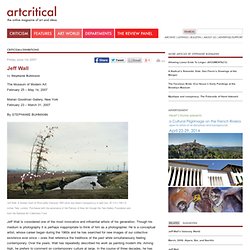

RealTime Arts - Magazine - issue 110 - photographic uncertainties. The image captures some of Wall’s endearing concerns.

He has carefully staged a chance moment, which constructs a scene that he has already imagined in his mind’s eye. While it is at first glance a naturalistic scene, a second glance tells us that it has been heavily constructed, and yet this artificial sensibility carries with it a trace of something natural, some pivotal and beautiful quality of the world that Wall has managed to distil. The body of criticism around the work of Jeff Wall emphasises the staged performativity of the encounters he sets into large photographs and light boxes. There is a captivating uncertainty in a piece like Knife Throw (2008), whose performers act out what they might ordinarily do in their own lives, by throwing knives at a wall. Yet their performance is far from natural, and carries with it a self-consciousness or even boredom that lies ambivalently in the posture and face of one of the men.
Not all of Wall’s works are so successful. Back to top. Photographer Jeff Wall on "After 'Invisible Man' by Ralph Ellison, the Prologue" (1999-2000) Thomas Demand. Even though he uses photography, Thomas Demand (b. 1964) does not regard himself as a photographer, but rather as a conceptual artist.

Very often a known image - published for example in a newspaper - is the starting point of Demand’s creative process. NGV > Explore > NGV Digital > View. Photografs like Paintings - Jeff Wall in Dresden. Image and Narrative - Article. Absorption today Fig.1 Jeff Wall, Morning Cleaning, Mies Van der Rohe Foundation, Barcelona, 1999, transparency in lightbox, 187 x 351 cm.

Courtesy of the artist. Michael Fried argues that Jeff Wall's Morning Cleaning, Mies Van der Rohe Foundation, Barcelona (1999) (Fig. 1) is an outstanding example of a work that revives the absorptive painterly tradition in a contemporary mode. Morning Cleaning produces for its viewers the ‘magic of absorption’ in an extremely accomplished way, with ‘great pictorial and intellectual sophistication’ (Fried 2007: 517; Fried 2008: 75).
Its ‘appeal to absorption’ is achieved in a dual manner. Photography Theory in Historical Perspective - Hilde Van Gelder, Helen Westgeest. Sugimoto, Hiroshi: Theaters. Hiroshi Sugimoto«Theaters» Since the 1970s, Sugimoto has worked on his photo-series entitled «Theaters,» in which he photographs auditoriums of American movie theaters, and drive-in movies, during showings.

The exposure time used for the photograph corresponds with the projection time of the film. This allows him to save the duration of the entire film in a single shot. What remains visible of the film’s time-compressed, individual images is the bright screen of the movie theater, which illuminates the architecture of the space. That its content retreats into the background makes the actual film a piece of information, manifesting itself in the (movie theater) space. «One night I had an idea while I was at the movies: to photograph the film itself. (Source: Cat. Heike Helfert. Cindy Sherman: It Began with Madame de Pompadour. Cindy Sherman in front of her work, "Untitled (#216)" (1989), at Skarstedt Gallery, New York, 2008.

Production still from the "Art in the Twenty-First Century" Season 5 episode, "Transformation," 2009. © Art21, Inc. 2009. In 2008, twenty of Cindy Sherman's History Portraits (1989–1990) were exhibited at Skarstedt Gallery in New York City. In the following interview, Sherman walks Art21 through the exhibition and discusses the ideas behind individual photographs as well as the overall series. ART21: What was the impetus for History Portraits? SHERMAN: This piece [Untitled (#183 A)] was sort of where it all began. ART21: Is this Madame herself or is this your idea of her? SHERMAN: Like everything I do, I wasn’t really trying to copy any picture of Madame de Pompadour, but to look like someone like Madame de Pompadour.
Jeff Wall. The Museum of Modern Art February 25 – May 14, 2007 Marian Goodman Gallery, New York February 23 – March 31, 2007 By STEPHANIE BUHMANN Jeff Wall, A Sudden Gust of Wind (after Hokusai) 1993 silver dye bleach transparency in light box, 87-1/4 x 148-1/2 inches Tate, London.

Purchased with the assistance of the Patrons of New Art through the Tate Gallery Foundation and from the National Art Collections Fund Jeff Wall is considered one of the most innovative and influential artists of his generation. When viewing a large group of Wall’s works at his current retrospective at the Museum of Modern Art, it becomes clear that his pictorial ambitions are inseparable from the distinct way the work is displayed. Wall’s early passions were painting and art history. Michael Fried: About the Tableau. Michael Fried on Why Photography Matters. Once Michael Fried starts talking about photography his enthusiasm is infectious: ‘What I was seeing was people standing in front a work by Jeff Wall for twenty or twenty five minutes - and talking about it, discussing it, pointing out things. And I thought, “Man, this is great; this is just good in itself”. I’d say to my painter friends - even the ones who are still abstract painters - “Photography is on your side – just wait.”
Because photography is making people look closely again, and in itself that is simply marvellous.’ Constructed Realities: The Art of Staged Photography: Zdenek Felix, Andreas Vowinckel, Michael Kohler: 9783905514544: Amazon.com.